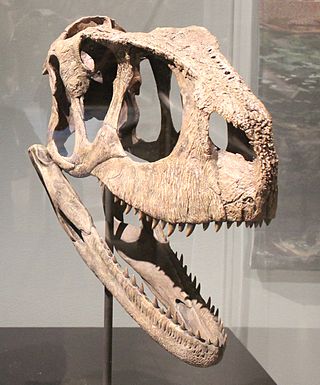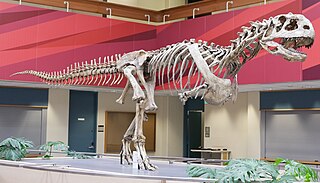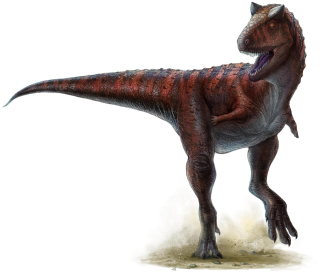
Carnotaurus is a genus of theropod dinosaur that lived in South America during the Late Cretaceous period, probably sometime between 71 and 69 million years ago. The only species is Carnotaurus sastrei. Known from a single well-preserved skeleton, it is one of the best-understood theropods from the Southern Hemisphere. The skeleton, found in 1984, was uncovered in the Chubut Province of Argentina from rocks of the La Colonia Formation. Carnotaurus is a derived member of the Abelisauridae, a group of large theropods that occupied the large predatorial niche in the southern landmasses of Gondwana during the late Cretaceous. Within the Abelisauridae, the genus is often considered a member of the Brachyrostra, a clade of short-snouted forms restricted to South America.

Abelisaurus is a genus of predatory abelisaurid theropod dinosaur alive during the Late Cretaceous Period (Campanian) of what is now South America. It was a bipedal carnivore that probably reached about 7.4 metres in length, although this is uncertain as it is known from only one partial skull.

Rugops is a monospecific genus of basal abelisaurid theropod dinosaur from Niger that lived during the Late Cretaceous period in what is now the Echkar Formation. The type and only species, Rugops primus, is known only from a partial skull. It was named and described in 2004 by Paul Sereno, Jeffery Wilson and Jack Conrad. Rugops has an estimated length of 4.4–5.3 metres and weight of 410 kilograms. The top of its skull bears several pits which correlates with overlaying scale and the front of the snout would have had an armour-like dermis.

Abelisauridae is a family of ceratosaurian theropod dinosaurs. Abelisaurids thrived during the Cretaceous period, on the ancient southern supercontinent of Gondwana, and today their fossil remains are found on the modern continents of Africa and South America, as well as on the Indian subcontinent and the island of Madagascar. Isolated teeth were found in the Late Jurassic of Portugal, and the Late Cretaceous genera Tarascosaurus and Arcovenator have been described in France. Abelisaurids first appear in the fossil record of the early middle Jurassic period, and at least three genera survived until the end of the Mesozoic era 66 million years ago.

Abelisauroidea is a diverse superfamily of ceratosaurian dinosaurs, typically regarded as a Cretaceous group, though the earliest abelisaurid remains are known from the Middle Jurassic of Argentina and possibly Madagascar. Possible Abelisauridae remains were also discovered in Late Jurassic Tendaguru Beds in Tanzania.

Quilmesaurus is a genus of carnivorous abelisaurid theropod dinosaur from the Patagonian Upper Cretaceous of Argentina. It was a member of Abelisauridae, closely related to genera such as Carnotaurus. The only known remains of this genus are leg bones which share certain similarities to a variety of abelisaurids. However, these bones lack unique features, which may render Quilmesaurus a nomen vanum.

Mapusaurus was a giant carcharodontosaurid carnosaurian dinosaur from the early Late Cretaceous, approximately 93.9 to 89.6 million years ago, of what is now Argentina.

Ekrixinatosaurus is a genus of abelisaurid theropod which lived approximately 100 to 97 million years ago during the Late Cretaceous period. Its fossils have been found in Argentina. Only one species is currently recognized, Ekrixinatosaurus novasi, from which the specific name honors of Dr. Fernando Novas for his contributions to the study of abelisaurid theropods, while the genus name refers to the dynamiting of the holotype specimen. It was a large abelisaur, measuring between 6.5 and 8 m in length and weighing 800 kg (1,800 lb).
The Huincul Formation is a geologic formation of Late Cretaceous age of the Neuquén Basin that outcrops in the Mendoza, Río Negro and Neuquén Provinces of northern Patagonia, Argentina. It is the second formation in the Río Limay Subgroup, the oldest subgroup within the Neuquén Group. Formerly that subgroup was treated as a formation, and the Huincul Formation was known as the Huincul Member.

Carnotaurinae is a subfamily of the theropod dinosaur family Abelisauridae. It includes the dinosaurs Aucasaurus, Carnotaurus. The group was first proposed by American paleontologist Paul Sereno in 1998, defined as a clade containing all abelisaurids more closely related to Carnotaurus than to Majungasaurus.

Carnotaurini is a tribe of the theropod dinosaur family Abelisauridae from the Late Cretaceous period of Patagonia. It includes the dinosaurs Carnotaurus sastrei; the type species, Aucasaurus garridoi, and Abelisaurus comahuensis. This group was first proposed by paleontologists Rodolfo Coria, Luis Chiappe, and Lowell Dingus in 2002, being defined as a clade containing "Carnotaurus sastrei, Aucasaurus garridoi, their most recent common ancestor, and all of its descendants."

Skorpiovenator is a genus of abelisaurid theropod dinosaur from the Late Cretaceous Huincul Formation of Argentina. It is one of the most complete and informative abelisaurids yet known, described from a nearly complete and articulated skeleton.
Taurovenator is a medium-sized carcharodontosaurid theropod from the late Cretaceous of Argentina. Discovered by Matias Motta in 2005 and formally described in 2016, it is represented by an isolated right postorbital.

Furileusauria is an extinct clade of derived abelisaurid dinosaurs only known from South American fossil remains. They represent some of the largest members of the Abelisauridae, with an average length of 7.1 ± 2.1 m (23.3 ± 6.9 ft). The clade is defined as the most inclusive clade containing Carnotaurus sastrei but not Ilokelesia aguadagrandensis, Skorpiovenator bustingorryi, or Majungasaurus crenatissimus.

Overoraptor is an extinct genus of paravian theropod of uncertain affinities from the Late Cretaceous Huincul Formation of Argentinian Patagonia. The genus contains a single species, O. chimentoi, known from several bones of the hands, feet, and hips alongside some vertebrae.

Niebla is a genus of abelisaurid theropod dinosaur from the Late Cretaceous Period (Campanian-Maastrichtian) of Río Negro province, Argentina. The genus contains a single species, Niebla antiqua, and is known from a partial, non-articulated skeleton. The holotype, found in the Allen Formation, represents an adult individual.

Meraxes is a genus of large carcharodontosaurid theropod dinosaur from the Late Cretaceous Huincul Formation of Patagonia, Argentina. The genus contains a single species, Meraxes gigas.

Chucarosaurus is an extinct genus of titanosaurian dinosaur from the Late Cretaceous Huincul Formation of Argentina. The genus contains a single species, C. diripienda, known from various limb and pelvic bones.
Sidersaura is an extinct genus of rebbachisaurid sauropod dinosaur from the Late Cretaceous Huincul Formation of Argentina. The genus contains a single species, S. marae, known from the remains of four individuals. Sidersaura represents one of the largest known rebbachisaurids.

Chakisaurus is an extinct genus of elasmarian ornithopod dinosaur from the Late Cretaceous Huincul Formation of Argentina. The genus contains a single species, C. nekul, known from multiple partial skeletons belonging to individuals of different ages. Chakisaurus represents the first ornithischian species to be named from the Huincul Formation.





























